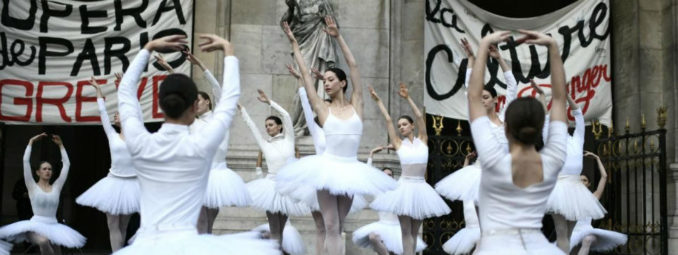French unions want retirement ‘reform’ scrapped
It was a tough holiday for transportation strikers in France. Their pay packet for December was basically empty.

A dancing picket line, Paris, Dec. 24
The struggle on the national railroad (SNCF) at 23 days is longer than a similar struggle over the SNCF retirement plan in 1995 and shows every sign of lasting longer than the 28-day struggle in 1986-87.
Protesters are still in the streets. The two most militant unions representing SNCF workers called for a march on Dec. 28 near the Paris railroad station Gare du Nord, which was broken up by cops firing tear gas after some bank windows were broken.
The public bank account set up by the General Confederation of Labor (CGT) for donations to support the strikers passed the million euro mark on Dec. 26. A big chunk of the money came from Twitch, a computer games network. At a rally in front of the headquarters of the Paris subway system, a high-ranking CGT leader, Marianne Ravaud, said, “This money came mostly in small donations from all over France. It shows the basis of our support.” Public opinion polls report that between 60 and 70 percent of people in France support the strike.
Most unions in France have no strike funds.
One of the eight refineries in France has been shut down by its unions at the CGT’s call. Gas company Total’s refinery at Grandpuits, about 50 miles southeast of Paris, is still shipping out product in trucks but has lost its pipeline connection, so it will soon have to stop. Scattered outages of certain types of fuel have been reported, making drivers nervous.
Picket lines have been set up at some bus depots from time to time, putting more pressure on the transportation system.
In a blatant attempt to divide workers in order to win, the government of Prime Minister Édouard Philippe has not invited the head of the CGT, Philippe Martinez, to the next meeting of the striking unions and the government. Meetings like this are generally where political strikes in France are settled.
Ballet dancers at the Paris Opera held a picket line on Dec. 24 in front of the Opera House by dancing some scenes from Swan Lake accompanied by Opera musicians. The dancers’ retirement system dates back to 1698 under Louis XIV. Dancers generally join the ballet corps between the ages of 8 to 10 and retire after 30 years of service, when they reach 42.

